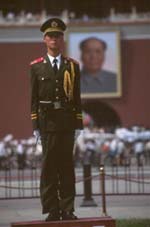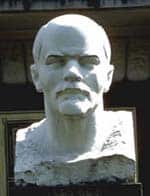.jpg)
In 1989, public assessment of hard-line communism as a future threat fell with the Iron Curtain. Public opinion, inebriated with dreams of a peace-filled, nuclear-free future, suppressed the Cold War from its memory like a tragic experience from childhood.
Even to mention the sobering reality of over one billion people enslaved in Red China, North Korea, North Vietnam and Cuba incurred the risk of being branded a depressing killjoy. Moreover, to suggest the rebirth of a military threat from the former Soviet empire was viewed as bordering on insanity.
Throughout the nineties, Americans adopted this optimistic mindset which together with economic prosperity, lulled public opinion into a dangerous sleep.
Today, however, those concerns are not so far fetched. Military buildups in the communist and former Iron Curtain countries are occurring and represent a serious threat to American security. Moreover, the resurgence of communist guerrillas in Latin America seems to have caught many by surprise.
Will this new military threat ever materialize? If so, where will it take shape? Only time can definitively answer these questions. However, three different areas could make this threat frighteningly real: China, Russia, and South America.

The Growth of the Red Dragon
The foremost prospect is Red China that is acting true to Mao’s maxim: “Every Communist must grasp the truth that political power grows out of the barrel of a gun.” China is building up its military with a vengeance. As General Henry H. Shelton, chairman of the Joint Chiefs of Staff, said in December, “They [the Chinese] are aggressively modernizing their military forces, both conventional as well as nuclear.”1
Nor is this an arbitrary buildup. General Chi Haotian, vice-chairman of the Communist Party’s Central Military Commission makes no qualms about the fact that the primary target is the United States.
“Viewed from the changes in the world situation and the hegemonic strategy of the United States to create monopolarity,” he said, “…war [between China and the United States] is inevitable.”2
Chinese actions around the world are completely consistent with such a view. At Los Alamos National Laboratory in New Mexico, China stole information on how to build every nuclear weapon in the American arsenal.3 In Panama, China illegally4 secured two of the most strategic docks in the canal where no less than 13% of all U.S. trade passes.
Nowhere is the China threat more real than near Taiwan, where buildup has been so extensive that they could effectively paralyze the entire island in 45 minutes. China has also taken steps that would neutralize American help by striking nearby U.S. bases and disabling satellites.5
The American mainland is also targeted. According to a report in the Liberation Army Daily, the official newspaper of the Peoples Liberation Army, ” a conflict over Taiwan could quicken escalate beyond the region. “[China] is a country that has certain abilities of launching a strategic counterattack and the capacity of launching a long distance strike. It is not a wise move to be at war with a country such as China, a point which the U.S. policymakers know fairly well also.”6

The Russian Bear Growls
Seventy-two years of communist domination left the former Soviet Union in a state of complete financial ruin. Despite massive aid dollars over the last decade, the misery continues, leaving a superficial observer with the impression that Russia is no longer a threat.
However, a closer look shows not only a resurgence of Marxist-Leninist ideology but a sizable military buildup bolstered by that universal equalizer of modern warfare, the nuclear bomb. Former Defense Secretary William Cohen warned last January 10 that Russia may not make the transition to democracy and free markets and could revert to its past role as a global threat.7
Disturbing signs are on the horizon that point in that direction. Russian President Vladimir Putin, for example, rather than rejecting their communist past as an inhumane dictatorship, is speaking well of it.
In December, he proposed bringing back the old national anthem together with all the other symbols of their Soviet past. Judging from the controversy unleashed in America by the use of the Confederate flag, the return of these oppressive symbols should be seen as significant. However, American liberals seem to have no problem with symbols that enslaved entire populations.
Even Lenin’s mummified body is still venerated in Red Square. President Putin is adamantly opposed to, “any action against Lenin’s body, his mausoleum or the numerous tombs (of Soviet leaders).”8 Instead of breaking with its totalitarian past, Russia is prolonging it, with acts akin to venerating Hitler’s remains in postwar Germany.
A December 2000 poll chose Lenin as “man of the century” in Russia. Stalin, responsible for the murder of over ten million people, came in second.9
Whatever the case, Russia seems to be back to its old tricks. It has reopened ties with the Ukraine and old allies and aggressively reentered the international arms markets. When Lithuania, Latvia, and Estonia sought to protect their independence by seeking membership in NATO, Russia immediately protested. Moreover, the Russians threatened to go back on their 1992 agreement to keep the Baltics nuclear free.10 Despite Russian denials, U.S. intelligence sources believe they made good on this threat by moving nuclear weapons into the area.11
If Russia has no plans of reestablishing itself as an anti-NATO power, why are they opposed to a strong NATO presence in the Baltics? As Senator Jesse Helms well said, “In looking at the current Russian government, one gets the distinct impression that the Russian leadership considers Baltic independence to be a temporary phenomenon.”12

Unfriendly Southern Neighbors
The U.S. also cannot ignore the resurgence of communist guerilla activity in Latin America which represents yet another military threat, albeit indirect.
This is very well exemplified in Colombia. The avowedly Marxist-Leninist group called FARC (Revolutionary Armed Forces of Colombia) is engaged in a 36-year civil war with the government. Its 17,000-member army, supported by limitless funds gained through kidnapping and drug trafficking, has proven strong enough to supersede proper authorities on several occasions. For example, last November, they closed the border between Ecuador and Colombia, burning the cars of anyone who tried to cross.13
Colombian President Andrés Pastrana gave them an area of land the size of Switzerland as a “safe-haven” in a policy akin to a man giving a bear a lunch box, hoping the bear will then be too stuffed to eat him. Rather than peace talk progress, the result has been continued terrorism.14 This terrorism however, is not limited to Colombia. FARC regularly crosses into Panama, Ecuador, and Venezuela.15
The communist threat extends to Venezuela’s President Hugo Chávez. True to his promise of revolution, the land reform supporting president rewrote the constitution and dismantled both the legislative and judicial branches of government, leaving himself as leader of the only existing branch. Last August, he threatened to use troops to crush street protests after one of his candidates was elected on shady grounds.16
Inspired by his admiration of Fidel Castro and his totalitarian regime, Chávez now sells Cuba oil at only two percent interest giving them 15 years to pay and a two year grace period. He did all this in spite of a $69 million debt which Cuba already has with Venezuela.17
The Jan. 27 issue of The Economist notes that Chávez is introducing new history textbooks with a Marxist perspective. For example, the Education Ministry recently held an essay competition highlighting the late Che Guevara as a role model for Venezuelan youth.
In fact, the Cuban link is popping up all over Latin America. All of this points to a resurgence of Marxist movements and the resurrection of the once moribund Marxist guerrilla.
Call to Wake Up
The military threat that extents from China to Latin America is a call for the free world to leave post-Cold War complacency. For the last eight years, the United States armed forces have suffered so many cutbacks by the Clinton Administration, that the Joint Chiefs of Staff Chairman, General Henry H. Shelton, estimates that $60 to $100 billion will be needed just to fix the problems they produced.18
With this in mind, the Bush Administration must make sure that America can meet the multiple aspects of this threat. As always, a strong military is the greatest hope for peace. The illustrious president Theodore Roosevelt showed true wisdom when he said, “Walk softly, and carry a big stick.”
___________
Footnotes
- Bill Gertz, “China Prepares for War with the U.S. over Taiwan,” The Washington Times, Nov. 11, 2000.
- Steven Mosher, “The New Cold War,” The Washington Times, Jan. 2, 2001.
- Bill Gertz, The China Threat, (Washington D.C.: Regency Publishing, 2000), p.124.
- Ibid., p.79-80 [Chapter 5].
- Ibid., p.192 [Chapter 8].
- Liberation Army Daily, Feb. 28, 2000 as cited by Ibid. pg. 177.
- Bill Gertz, “Russia Seen Relying on Nuke, Germ Weapons,” The Washington Times, Jan. 11, 2001.
- Patrick E. Tyler, “Moscow Journal: With Putin in Power, Lenin Should Rest in Peace,” The New York Times, Jan. 15, 2001
- Associated Press, “Russians Pick Lenin as ‘Man of the Century,’ Stalin as Runner-up,” Dec. 27, 2000.
- David R. Sands, “Baltics’ Bid to Join NATO Gets Touchy,” The Washington Times, Jan. 17, 2001.
- Bill Gertz, “Russia Transfers Nuclear Arms to Baltics,” The Washington Times, Jan. 03, 2001.
- Sands, op cit.
- Juan Forero, “Coca Conflict in Colombia Snares the Innocent,” The New York Times, Dec. 9, 2000.
- Reuters, “Colombia’s Leader Urges Rebels to Talk Peace,” The New York Times, Jan. 24, 2001.
- “Containing Colombia’s Troubles,” The New York Times, Jan. 15, 2001.
- Larry Rohter, “Chávez Says He Will Crush Political Foes In Venezuela,” The New York Times, Aug. 2, 2000.
- Alexander Olson, “Cuba, Venezuela Sign Oil Deal,” The Associated Press, Oct. 30, 2000.
- Bill Gertz, “General Shelton Sees China as Growing Threat to U.S.,” The Washington Times, Dec. 15, 2000.
